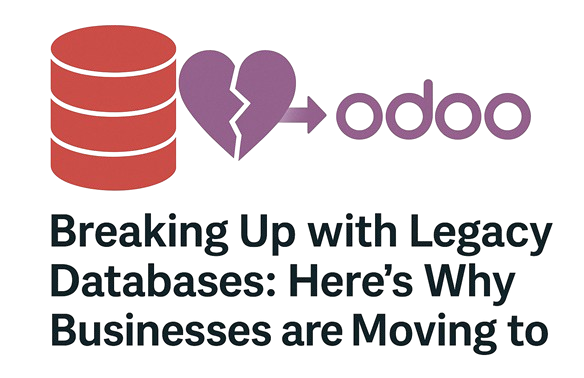
Legacy Databases: Once Reliable, Now a Roadblock
For decades, traditional databases like MySQL, Oracle, and SQL Server have been the backbone of enterprise operations. But as businesses scale, diversify, and digitize, these rigid, siloed systems are becoming pain points rather than powerhouses.
From integration nightmares to costly customizations, legacy solutions are slowing down innovation
Enter: Odoo— the all-in-one business management suite that’s reshaping the digital core of thousands of enterprises.
Why Odoo? The Core Benefits
Odoo is an open-source, modular ERP (Enterprise Resource Planning) system designed to centralize operationsacross departments — from CRM to accounting, HR, inventory, eCommerce, and more. Here’s why businesses are making the switch:
- Unified Platform: No need to stitch together multiple tools. Odoo handles it all under one roof.
- Modular Design: Choose from over 40 core applications and 26,000+ community modules.
- Cost-Effective: Unlike legacy systems, Odoo's open-source core means zero licensing fees for the Community edition.
- Flexible & Scalable: Whether you’re a startup or a global enterprise, Odoo scales with you.
- Modern UI/UX: Intuitive, responsive interfaces replace outdated legacy dashboards.
Odoo in Numbers
- Over 7 million users worldwide.
- Available in 65+ languages.
- Used in 120+ countries.
- Supported by a global network of 3,600+ partners.
These numbers are growing rapidly, proving that Odoo is not just an ERP — it’s a movement toward smarter, connected businesses.
Before You Switch: What to Keep in Mind
Before you move from your legacy system to Odoo, consider:
🔍 Data Migration:
Plan how to migrate your data securely.
🔌 Integration Needs:
Identify third-party systems you want Odoo to connect with.
🛠️ Customization Requirements
Map your workflows to Odoo modules — or customize.
👨💻 Implementation Partner:
Choose a certified partner to help with deployment and training.
Real-World Adoption
Brands across industries — including Toyota, Hyundai, and Danone — are using Odoo to power operations. From supply chain to sales, businesses are reporting 30–60% efficiency boosts post-implementation.
he Final Word
Switching from legacy databases to Odoo isn’t just a software upgrade — it’s a strategic transformation If you're looking to simplify, unify, and future-proof your business systems, Odoo is the break-up you won’t regret.